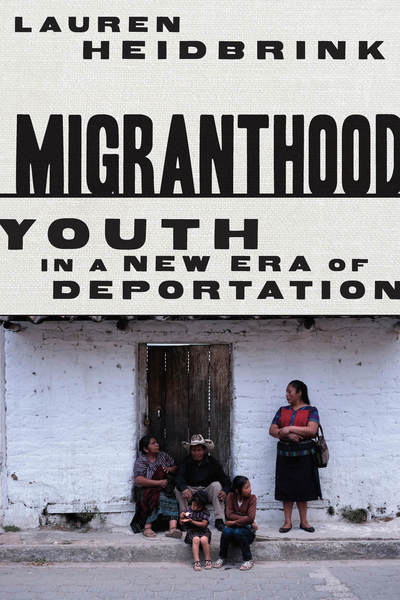
By Lauren Heidbrink, PhD.
“The Guatemalan government treats us like we don’t belong—even on the lands of our ancestors—and blocks us at every turn. Bad schools, no work, no medical care. They treat us like indios sucios [dirty Indians] while they rob gold from under our lands. Believe me, I never wanted to migrate. I’d heard the stories from my cousin–about the dangers of the journey, living in a cramped apartment, working twenty hours a day and never saving–but I had no choice. My mother and sister got sick; the [Marlin] mine contaminated our water and spoiled the crops. They call it “desarrollo” [development], but it is not developing our communities; it is devastating them. They are killing us slowly.”
– Juan Gabriel, seventeen years old
Juan Gabriel is one of a growing number of young people migrating unaccompanied from Central America to the United States. Often dismissed as mere victims of poverty or stigmatized as gang members, these young people are social actors who contribute to the survival of their households through their care, labor, and mobility. In spite of his desire to remain in Guatemala, Juan Gabriel migrated due to the environmental repercussions of a gold mine near his hometown of Sipacapa that imperiled his mother’s and sister’s health when it contaminated the soil and local water sources. The U.S. and Guatemalan governments contend that foreign investment—often in the form of extractive industries, free trade zones, and agricultural initiatives—create alternatives to migration through employment opportunities, improved infrastructure, and investment that, in theory, trickles down to communities. For Juan Gabriel, however, the adverse consequences resulting from “development” in tandem with a failing public health system spurred his transnational migration. For other young migrants, limited employment and education opportunities, high rates of unemployment, scarce arable land, financial debt, and family emergencies (such as accidents or death) prompted their migration.
The experiences of young migrants like those of Juan Gabriel are regularly overlooked, ignored, or discounted. They are relegated to simplified tropes of children left behind, abandoned, or dependent upon the actions and outcomes of adults. When the media and policymakers acknowledge young people’s migratory experiences, their perspectives often are overshadowed by advocates who claim to speak on their behalf. In contrast, my book Migranthood chronicles young people’s long-term trajectories of migration and deportation from their own perspectives. Through research with Indigenous (primarily Maya-Mam and K’iche’) children and youth ages 13 to 17) in diverse spaces and geographies—in communities of origin in Guatemala, zones of transit in Mexico, detention centers for unaccompanied minors in the United States, government facilities receiving returned children in Guatemala, and communities of return—young people share how they negotiate everyday violence and discrimination, how they and their families prioritize limited resources and make difficult decisions, and how they develop and sustain relationships over time and space. In other words, their lives are so much more than the migranthood ascribed to them.
Migranthood chronicles deportation from the perspectives of Indigenous youth who migrate unaccompanied from Guatemala to Mexico and the United States.
Alongside young people’s diverse migratory trajectories, Migranthood traces how securitized approaches to migration management, often under the guise of “development,” is a mode of governance that moves across and beyond geopolitical space. National and regional securitization programs, border externalization policies, and detention and deportation are enlisted to manage desired and undesired migrants, increasingly ensnaring children and youth in this global immigration dragnet. Although cast as objects of policy, not participants, Indigenous youth are not passive recipients of securitization policies, development interventions, or discourses of migranthood. Drawing on the resources of transnational kin, social networks, as well as financial institutions and actors, Indigenous youth enlist a rich social, cultural, and political repertoire of assets and tactics to navigate precarity and marginality in Guatemala. As I observed over five years of research, young people enact care and belonging through their paid labor, unpaid care work, and mobility. They shape household bonds and mediate conflict by providing emotional and social support to family members adapting to new cultural, social, and economic contexts. And, like Juan Gabriel, they migrate to ensure the survival of their multigenerational households amid marginality and precarity in Guatemala. By attending to young people’s perspectives, we learn the critical roles they play as contributors to household economies, local social practices, and global processes. In a new era of mass deportation, the insights and experiences of young people likewise uncover the transnational effects of the securitized responses to migration management and development on individuals and families and across space, citizenship status, and generations.
Nearly two years following his deportation to Sipacapa, Juan Gabriel shared, “I dream of the right to not migrate…of having the conditions in which I can choose to stay just like I can choose to leave, but you see the difference? It is a choice.” Explicitly acknowledging young people’s expertise and eliciting their insights creates opportunities to craft policies and programs that more accurately reflect their realities, and collaboratively enacts and ensures their right to not migrate.
About the Author
Lauren Heidbrink is an anthropologist and Associate Professor of Human Development at California State University, Long beach. She is author of Migrant Youth Transnational Families, and the State: Care and Contested Interests (U. of Pennsylvania Press 2014) and Migranthood: Youth in a New Era of Deportation (Stanford University Press 2020). She is co-editor of Youth Circulations.
